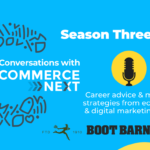During the holiday season, it is standard for retailers to see spikes in traffic. Planning for such spikes requires heavy planning with strategies like code freezes. Though traditional methods can work, many leading figures in the retail industry are advocating for making use of composable commerce as a better tool for spike preparation.
In our webinar, Treat Any Day Like Black Friday: How Composable Commerce Unwraps Your New Normal, we discussed the importance of composable commerce in modern operations.
Speakers
- Dylan Valade, Head of Global Ecommerce Technology at PUMA and Ambassador at MACH Alliance
- Deepa Shekhar, Director of Digital Marketing Technologies at Logitech
- Apurva Pangam, Principal at Deloitte Digital
- Kelly Goetsch, Chief Strategy Officer at commercetools
- Moderated by Veronika Sonsev, Co-Founder at CommerceNext
Watch the replay below and read the recap for the top takeaways.
Handling Unplanned Traffic and Peaks with Composable Commerce
commercetools leader Kelly Goetsch covered the different types of spikes we can anticipate in the ecommerce world: planned traffic, such as Black Friday or Mother’s Day, and the more challenging unplanned traffic. This webinar’s audience poll revealed that only 46% could support an unexpected spike, 19% claimed they could not, and 35% were unsure.
Unplanned traffic is unexpected, and happens quickly in the age of social media—one post from a celebrity or a mistake in labeling a discount could send major traffic to a website. It is extremely important for brands to have the resources to prepare for traffic even when it is unplanned.
Traditional methods of handling spikes, however, are not as efficient with unplanned spikes: code freezes, adding hardwares, 24/7 coverage, switching to asynchronous vendors and refusing traffic-driving opportunities. This last option is the most frustrating because brands can miss out on potential sales but typically have to worry about controlling traffic instead. These older methods are time-consuming and can hurt company success if not performed properly. In the modern era of technology, any day can be Black Friday. Any moment could require lockdown mode today. Enter: composable commerce.
Key Definitions
Before delving into composable commerce, we have to understand how to distinguish it. Composable commerce is often associated with headless commerce; however, they are different concepts. Composable commerce is utilized when brands compose a customer experience for their customer. Retailers can pick and choose across vendors the options that are most suitable for their needs. With headless support, the entire platform is used. The difference is in how technology is used, but not the technology itself.
commercetools uses robust technology that is rolled out incrementally so that no major change in operations will negatively affect services for its customers. Goetsch recommended having complete control over the code source and using methods like SaaS to auto-scale. He advocated for monitoring and support 24/7, selecting robust vendors and architecting smarter. According to Goetsch, load size should not matter when using MACH-based technology.
How Brands Are Utilizing Composable Commerce
Moving to Composable Commerce
PUMA has been utilizing composable commerce for years to ease traffic peaks—over half of PUMA’s technology is composable. Dylan Valade shared how over his six years at PUMA, the company transformed from a “war room” scenario in which peaks caused stress and crisis into a system that can withstand lots of traffic. PUMA has worked on protecting itself from every system that could fail, so over time it could support several international markets. Valade used the analogy of Legos to visualize how different technologies could be utilized for each market’s needs.
Logitech is on a different journey, now facing a hybrid system of some composable commerce. Deepa Shekhar shared how Logitech started late last year with its composable commerce process because it wanted to take ownership of its own system rather than using third-party services. Shekhar also recognized that headless commerce is more beneficial than its current system, and that Logitech is heading towards this path.
Composable Commerce in Preparing for Spikes
According to PUMA, no matter how much stress testing you perform, you cannot prepare for every spike scenario or else you can cause your own outage. PUMA launched a composable setup system this year in which its commerce system ran with a separate application for consumers to visit. When people automated buying PUMA’s hot products, their websites were slammed. Composable commerce was the best structure, as PUMA was able to recover faster and insulate from the systems that could not recover as quickly. This system allowed for less intense preparation for spikes.
Logitech is still working on scaling all of its systems, but its focus has changed to more operational priorities. Shekhar shared that they are testing more tools for consumers to utilize. A good testing strategy has also been imperative for their success.
The Current State of Technology
Deloitte Digital talked a little about the issue of throttling. Throttling in the modern age is more pertinent to supply of product itself rather than technological issues. Worrying about bots crashing sites seems to be more of an issue of the past.
commercetools brought up that more companies are capitalizing on one software product specifically. There is an open market full of technologies, which also creates more of a need to monitor. Valade shared that companies must have specific services to monitor different areas. To troubleshoot issues, monitoring is key. This is a benefit of composable commerce–companies can better address where the issues in their technology actually lies once they find out which system is problematic.
Pangam nonetheless advocated for composable teamwork as well. At Deloitte Digital, progressing to new technologies requires a formation of members of teams that can adapt to such changes. This does not require specialists but rather a retraining of the team.
Goetsch stresses that composable commerce is not a perfect system, and many other factors like the maturity of a company must be considered in evaluating a company’s handling of traffic.
Final Thoughts On Composable Commerce Journeys
Our speakers ended with some quick pieces of advice for our audience that we thought would be helpful to share:
- PUMA recommended leaning into the people they trust already (both vendors and internally) and asking them about recommendations for composable commerce. He also said that operating during business hours has been crucial for his team’s success.
- commercetools advised starting small and slowly chipping away at new feats with composable commerce.
- Deloitte Digital said that retailers need to be patient during the transition process to composable commerce and should embrace the agile journey.
- Logitech recommended expanding on existing values within a company to branch out into new realms of ecommerce.
Our webinar today covered many important topics about the benefits and realities of composable commerce. To learn more insightful tips about the retail industry, be sure to register for our upcoming Ecommerce Growth Show in NYC in June 2023.
Related Posts
-
Optimizing Ecommerce For The Gift Buyer
The most popular gift-shopping time of the year is just…
-
How E.L.F. BEAUTY Connects With Gen Z Consumers
In a previous blog, we covered the best ways to…
-
Optimization Tactics to Deliver a Better, More Human Digital Experience
It’s no secret that optimization improves your digital experience—customers have…
-
New CommerceNext Research: Understanding Today’s Digital Commerce Team
CommerceNext’s newest qualitative research report focuses on helping the ecommerce…
-
Season 3 Podcast Highlights: Strategies for Digital Commerce
In the third season of Conversations with CommerceNext, we’ve had…
-
SMS and the State of Conversational Commerce in 2022
Many brands have adopted SMS marketing in their strategies over…








